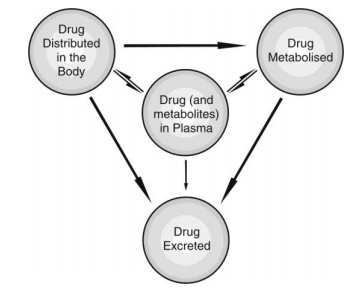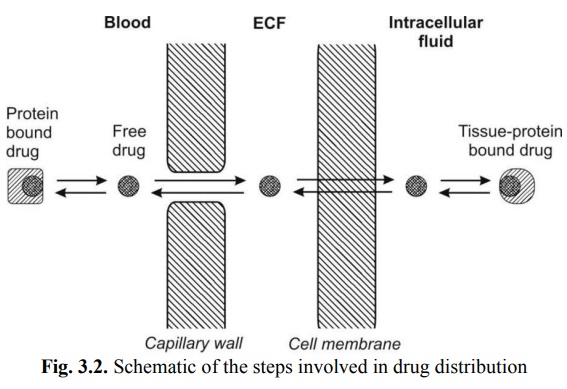Distribution of Drugs
| Home | | Biopharmaceutics and Pharmacokinetics |Chapter: Biopharmaceutics and Pharmacokinetics : Distribution of Drugs
After entry into the systemic circulation, either by intravascular injection or by absorption from any of the various extravascular sites, the drug is subjected to a number of processes called as disposition processes.
Distribution of Drugs
After entry into the systemic circulation, either by intravascular injection or by absorption from any of the various extravascular sites, the drug is subjected to a number of processes called as disposition processes. Disposition is defined as the processes that tend to lower the plasma concentration of drug. The two major drug disposition processes are –
1. Distribution which involves reversible transfer of a drug between compartments.
2. Elimination which causes irreversible loss of drug from the body. Elimination is further divided into two processes –
(a) Biotransformation (metabolism)
(b) Excretion.
The interrelationship between drug distribution, biotransformation and excretion and the drug in plasma is shown in Fig. 3.1.

Fig. 3.1. Interrelationship between different processes of drug disposition
As stated above, distribution is defined as the reversible transfer of a drug between one compartment and another. Since the process is carried out by the circulation of blood, one of the compartments is always the blood or the plasma and the other represents extravascular fluids and other body tissues. In other words, distribution is reversible transfer of a drug between the blood and the extravascular fluids and tissues. Distribution is a passive process, for which, the driving force is concentration gradient between the blood and the extravascular tissues. The process occurs by diffusion of free drug only until equilibrium is achieved. As the pharmacological action of a drug depends upon its concentration at the site of action, distribution plays a significant role in the onset, intensity and sometimes duration of drug action.
Steps in Drug Distribution
Distribution of drug present in systemic circulation to extravascular tissues involves following steps (see figure 3.2) –
1. Permeation of free or unbound drug present in the blood through the capillary wall (occurs rapidly) and entry into the interstitial/extracellular fluid (ECF).
2. Permeation of drug present in the ECF through the membrane of tissue cells and into the intracellular fluid. This step is rate-limiting and depends upon two major factors –
(a) Rate of perfusion to the extracellular tissue
(b) Membrane permeability of the drug.

Factors Affecting Distribution of Drugs
Distribution of a drug is not uniform throughout the body because different tissues receive the drug from plasma at different rates and to different extents. Differences in drug distribution among the tissues essentially arise as result of a number of factors as enumerated below –
1. Tissue permeability of the drug:
a. Physicochemical properties of the drug like molecular size, pKa and o/w partition coefficient
b. Physiological barriers to diffusion of drugs
2. Organ/tissue size and perfusion rate
3. Binding of drugs to tissue components:
a. Binding of drugs to blood components
b. Binding of drugs to extravascular tissue proteins
4. Miscellaneous factors:
a. Age
b. Pregnancy
c. Obesity
d. Diet
e. Disease states
f. Drug interactions.
Related Topics
